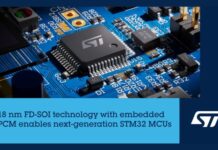The molecular electronics platform has a programmable sensor with a scalable sensor array architechture. A precision-engineered molecular wire is built to span nanoelectrodes that couple it into the circuit, and each member of the array is made up of an electrical current metre that measures the current flowing through it.
“Biology works by single molecules talking to each other, but our existing measurement methods cannot detect this,” said co-author Jim Tour, Ph.D., a Rice University chemistry professor and a pioneer in the field of molecular electronics. “The sensors demonstrated on these molecular communications, enabling a new and powerful view of biological information. “These picoamp-scale current-versus-time measurements are read out from the sensor array in digital form, at a rate of 1000 frames per second, to capture molecular interactions data with high resolution, precision and throughput.
“The goal of this work is to put biosensing on an ideal technology foundation for the future of precision medicine and personal wellness,” added Roswell co-Founder and Chief Scientific Officer Barry Merriman, Ph.D., the senior author of paper. “This requires not only putting biosensing on chip, but in the right way, with the right kind of sensor. We’ve pre-shrunk the sensor element to the molecular level to create a biosensor platform that combines an entirely new kind of real-time, single-molecule measurement with a long-term, unlimited scaling roadmap for smaller, faster and cheaper tests and instruments.
“The new molecular electronics platform detects multi-omic molecular interactions at the single-molecule scale, in real-time. The PNAS paper presents a wide array of probe molecules, including DNA, aptamers, antibodies, and antigens, as well as the activity of enzymes relevant to diagnostics and sequencing, including a CRISPR Cas enzyme binding its target DNA. It illustrates a wide range of applications for such probes, including the potential for rapid COVID testing, drug discovery and proteomics”.















